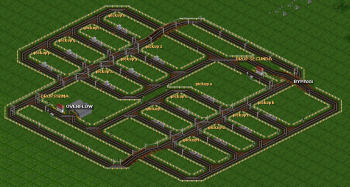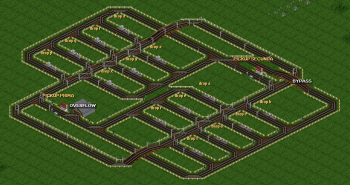Difference between revisions of "Multipoint Self-regulating Network"
From #openttdcoop wiki
(extention to SRNW concept) |
m |
||
| Line 3: | Line 3: | ||
Regular coopers approach with having single processing point for cargo type is not suitable for setup where an industry can only deal with set amount of delivered input over time. There is also another complication - processing speed grows over time as well as fluctuates a bit which requires a lot of station and train management. MSRN is based on same principles as SRNW but takes extra steps to deal with multiple drop or pickup points. MSRN can be equally used for "many pickups to few drops" or for "few pickups to many drops" scenarios. | Regular coopers approach with having single processing point for cargo type is not suitable for setup where an industry can only deal with set amount of delivered input over time. There is also another complication - processing speed grows over time as well as fluctuates a bit which requires a lot of station and train management. MSRN is based on same principles as SRNW but takes extra steps to deal with multiple drop or pickup points. MSRN can be equally used for "many pickups to few drops" or for "few pickups to many drops" scenarios. | ||
| − | [[File:MSRN-D.png]] [[File:MSRN- | + | [[File:MSRN-D.png|350px|thumb||Drop based MSRN]] [[File:MSRN-P.png|350px|thumb||Pickup based MSRN]] |
As name suggests main difference from regular SRNW is introduction of addition drop/pickup points along the way with possibility to bypass them in case if station is not ready (very important in case if it is a pickup). There still only one order for dummy trains - go from PRIMA, secondary or tertiary drops are just happen to be in a way of "already used" dummy trains as they try to get to it. At same time SRNW limitation of single cargo type per network still applies. | As name suggests main difference from regular SRNW is introduction of addition drop/pickup points along the way with possibility to bypass them in case if station is not ready (very important in case if it is a pickup). There still only one order for dummy trains - go from PRIMA, secondary or tertiary drops are just happen to be in a way of "already used" dummy trains as they try to get to it. At same time SRNW limitation of single cargo type per network still applies. | ||
Revision as of 12:53, 25 February 2010
Multi-point Self-regulating Network (MSRN) is an enhancement of SRNW design aimed to help with adapting SRNW concept to capacity oriented industry sets such as PBI, ECS or FIRS.
Regular coopers approach with having single processing point for cargo type is not suitable for setup where an industry can only deal with set amount of delivered input over time. There is also another complication - processing speed grows over time as well as fluctuates a bit which requires a lot of station and train management. MSRN is based on same principles as SRNW but takes extra steps to deal with multiple drop or pickup points. MSRN can be equally used for "many pickups to few drops" or for "few pickups to many drops" scenarios.
As name suggests main difference from regular SRNW is introduction of addition drop/pickup points along the way with possibility to bypass them in case if station is not ready (very important in case if it is a pickup). There still only one order for dummy trains - go from PRIMA, secondary or tertiary drops are just happen to be in a way of "already used" dummy trains as they try to get to it. At same time SRNW limitation of single cargo type per network still applies.

